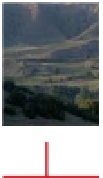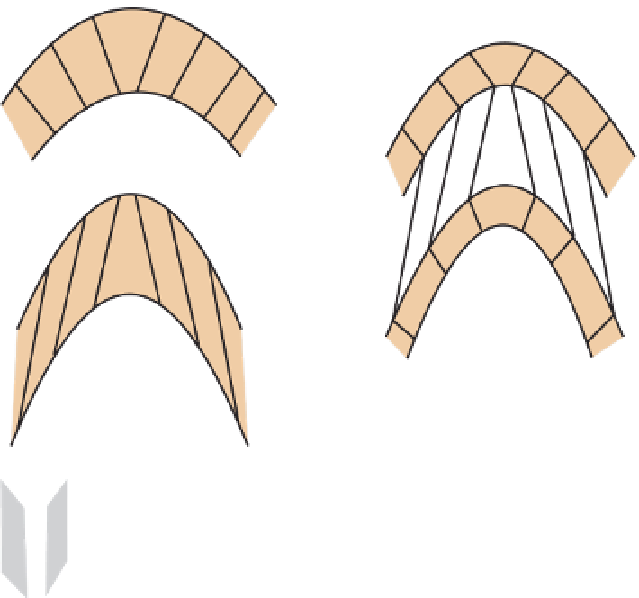Geology Reference
In-Depth Information
Effect of pressure solution
All three types of cleavage mentioned
above may be modified by the effects
of pressure solution and re-deposition
of soluble material forming part of the
rock body. This effect is discussed in
chapter 4 (
see
Figures 4.12E, F). The
more easily soluble rock material, such
as calcite or quartz, may be dissolved in
zones of high compressive stress, and
re-deposited in zones of low stress. The
removal of light-coloured material in
the high-stress zones will result in these
zones becoming darker than the sur-
rounding areas, causing the fabric to
become accentuated by the formation
of alternating darker and lighter bands
(Figures 7.1D; 7.2D, E). This effect is par-
ticularly common in asymmetric crenu-
lation cleavage, where material from the
long limbs of the asymmetric microfolds
has been dissolved and re-deposited in
the short limbs, as shown in Figure 7.2E.
7
A
58
59
C
B
E
Figure 7.2
A-C, cleavage fans:
A.
Convergent fan: the cleavage planes converge downwards.
B.
Divergent fan: the cleavage planes diverge downwards (parallel to the black lines).
C.
In
alternating competent and incompetent layers, cleavage alternates between convergent in the
more competent layers and divergent in the more incompetent layer. In competent layers affected
by buckling, originally vertical cleavage is rotated, whereas the incompetent layer is affected by
flexural shear.
D.
Symmetric and E, asymmetric crenulation cleavage. The cleavage, emphasised
by the grey bands, is produced by alternating dark and light bands, the darker bands having been
affected by pressure solution.
D
Spaced cleavage
This purely descriptive term can be
applied to any type of cleavage in
which the individual fabric planes are
obviously separated by zones of un-
cleaved rock. Figure 7.1D is a good
example. Thus all examples of frac-
ture cleavage and crenulation cleav-
age may also be described as '
spaced
cleavage'
. Even slaty cleavage, if seen
under the microscope, may appear
to be spaced, although the term
'spaced cleavage' is normally applied
to cleavages seen at outcrop scale.
Crenulation cleavage
As the name indicates,
crenulation
cleavage
is produced by crenulations,
which are closely-spaced microfolds, of
the order of millimetres or less in width.
Figure 7.2D and E show two examples,
formed respectively from symmetric
and asymmetric crenulations. The
cleavage, when viewed at outcrop scale,
has the appearance of a set of bands
that cut across the original layering, as
shown in Figure 7.1C. The crenulations
themselves must be
similar
or near-
similar in style (
see
Chapter 5) for the
structure to persist through successive
layers without any change in shape.
Crenulation cleavage is typically accom-
panied by
pressure solution
(
see
below)
which accentuates the fabric by forming
alternating darker and lighter bands.
Since this type of cleavage requires a
set of uniform thin layers for its forma-
tion, it is typically found in rocks that
have already acquired a strong foliation,
such as slates or schists. It is therefore
a common product of second or subse-
quent phases of deformation in multi-
ply deformed metamorphic terrains.
Schistosity and gneissosity
Planar fabrics in more coarsely crys-
talline metamorphic rocks, i.e. those
above slate grade, may take the form of
schistosity or gneissosity.
Schistosity

















Search WWH ::

Custom Search